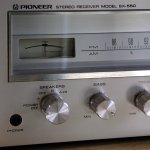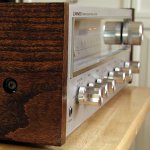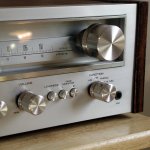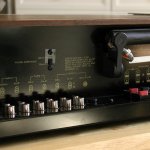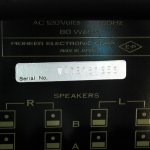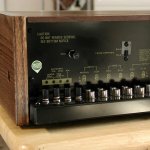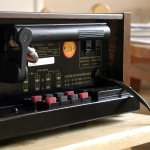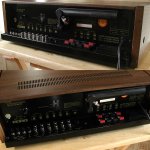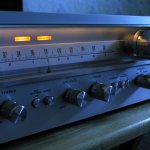My latest project is out on Reverb.com and it's been a very fun and inspiring one indeed.
A few years back I was doing quite a bit of repair work and learned that the region of Washington state were I lived at the time lacked anyone with my audio electronics skills or at least ones willing to do repairs. This led to becoming the local music store repair guy and what an adventure that turned out to be. At some point a discussion with my wife led to the interesting idea of taking my favorite repairs, the vintage stereos, and turning them into a different sort of side job. For some reason Pioneer turned out to be my favorite and we found several specimens on ebay that were seriously ready for some love.
Then an interesting guitar effects pedal related collaboration came along and that put off the stereo project for few years but now I'm getting around to restoring those Pioneers with great care.
This SX-550 opened my ears well beyond what I thought it would. In fact, it's now become quite the friend in the office portion of my lab where my burn-in process for this unit ended up being far more extensive than I thought it would be. I'm not easy to please regarding audio and I can tell you that I love to power this one up every morning. I also discovered that an FM station in my area plays 70s music all day Saturday and that proved to be interesting. For the first time in a very long time I'm listening to FM again. Weird. I'm even listening to the few vinyl records that I still have.
The SX-550 is now on Reverb.com!
https://reverb.com/item/82314088-pioneer-sx-550-1976-brushed-aluminum-oak-veneer

Pioneer SX-550 – Manufactured September 1976
Restoration by Retrofier Labs
The Restoration Details:
Complete Electrolytic Capacitor Replacement or “Recap” - This includes the substitution of several small value electrolytic capacitors with equivalent film capacitors for low distortion and reliability.
All Controls Cleaned and Lubricated - All of the potentiometers and switches were thoroughly cleaned and lubricated using air and Deoxit.
Solder Connections - The entire system was visually inspected and any suspect solder connections/joints were reworked.
Dial Cord Replaced - The dial cord in stereos of this vintage are often intact but slipping and making creaking sounds as they have lost their flexibility with age. The cord in this unit was replaced with a proper equivalent of the original and the pointer track was also lubricated for smooth and quiet tuning.
Tuning Control Shaft Assembly Rebuilt - The big knob with the heavy flywheel that gives the tuner it's 1970s feel is mounted on a brass shaft/sleeve assembly that often looses it's lubrication over time and sometimes completely seizes. It must be disassembled, cleaned, lubricated, reassembled, and carefully adjusted for the appropriate shaft end-play. This has all been done for this unit and it feels very much as it would have in 1976.
Dial Lamps Replaced - Quite often you will see old stereos with the lamps replaced with LED equivalents and that works, but I prefer incandescent lamps that give the vintage glow and maintain the original look as much as possible. The lamps I use run cooler and last longer than the originals and don't flicker or generate radio interference. Many of the original Pioneer lamps are are still working after nearly 50 years and the replacements in this unit can in theory run much longer.
Power Amplifier restoration and upgrades:
The original SX-550 is rated at 0.3% THD @ 20 Watts and 0.07% @ 10 Watts. This rather high and inconsistent distortion was mostly due to the poor quality (by today’s standards) output transistors causing significant large signal distortion that has been removed from this unit using much higher quality modern devices and proper bias adjustment using a distortion analyzer. The sound is now very pristine.
Power Switch Rebuild - The Pioneer SX-450 and the SX-550 had a rotary power switch that often developed arcing problems after many years of use and this caused behavior that can be very misleading as the symptoms suggest other problems.
The good news is that these were very well made switches that can be disassembled, cleaned, lubricated, and reassembled to end up with essentially a new switch. The contacts have generous material to be resurfaced and should last another 48 years. This unit's switch was not an exception and after the rebuilding, it works like new.
Real Oak Veneer! - The Pioneer SX-450 and SX-550 and likely others have metal top covers that are almost always like new. For some reason the material used to simulate wood for the top piece seems to last forever.
The particle board end caps are another matter. These are always in poor to very bad condition. My solution for this problem is to strip away all of the plastic material and refinish them with real wood veneer. This gives the end caps a truly "high end" and better than new appearance. I stain them to reasonably agree with the color of the top and and finish them off with water based polyurethane. This particular unit has Oak veneer and looks really cool.
Tuner Alignment Tested - The AM and FM tuners in the SX-550 use ceramic filters and what alignment is adjustable is rarely off. Nonetheless, it's good to test for any significant error and I do. This unit's tuner could not be improved by any adjustment and it sounds very good. All is well.
Headphone Output Recalibrated - The headphone output of the SX-550 as with most others of the era were designed for 8 Ohm headphones which today is not so common. Older stereos like this used a simple technique of dropping the power amplifier output with a resistor to get the headphone output to a reasonable level. The problem is that most headphones have much higher impedance these days and to complicate things further, there is no standard for headphone impedance(that I know of) and the range is pretty crazy at about 8 to 300 or more Ohms.
What I decided to do for this SX-550 is change the resistor to be ideal at the 64 Ohms of my Sennheiser HD 280 headpones which are very popular and sound very good. This is not to say that others will not work, it’s a matter of the volume level and with the range of the SX-550’s volume control there shouldn’t be problem for most headphones.
Cleaning and General Condition - The exterior of this unit was throughly cleaned but not altered in any way. All of the paint and brushed aluminum surfaces are original. All of the nicks, scratches etc. are very small and not generally noticable. Overall it's almost like new. The glass is in pristine condition and the black printed lettering on the front panel is incredibly free of defects. A very well preserved stereo that's nearly 48 years old.
Output Power - The SX-550 is rated at 20 Watts per channel @ 8 Ohms and it isn’t rated for lower impedances.
But how loud is that and what do you really need?
Where this Pioneer model is concerned I can share my experience because I use one every day. My SX-550 is connected to some nice but very inefficient bookshelf speakers situated a few feet away and I have carefully measured the output power under various listening conditions. What I discovered was that I use even less power than thought.
First I should point out that the only case where I might consume the entire 20 Watts of the SX-550 is when I hear a good song on FM or maybe want to play along with a song and crank it up a bit. The peaks in this case can get close to 20 Watts while the nominal or average is about 300 mW or 0.3 Watts. My perception of the loudness at this level is that I would not go this loud if I lived in an apartment and I’m talking about 5 inch woofers. It fills the room surprisingly well.
My general conclusion from these tests is that 20 Watts is plenty for my use and most of the time I only need 5 Watts for peaks, not 20.
This is simply an example based on my personal opinion to give some idea of what 20 Watts means in a practical situation at home with modest speakers. It’s really a very useful level of power and does not leave me wanting. With larger and more efficient speakers which also have more bandwidth, 20 Watts is more than enough from my experience.
Vinyl Record Playback? - The moving magnet preamp/EQ had it’s electrolytic capacitors replaced with film types and is now within specifications for the SX-550. By listening, it sure seems to work well. I played several records ranging from horrible scratchy things to wonderful clean specimens and they all seem to sound as they should.
What Did It Cost New? - In 1976 the SX-550 sold for $250.000 USD which in 2023 USD would be $1278.44.
A few years back I was doing quite a bit of repair work and learned that the region of Washington state were I lived at the time lacked anyone with my audio electronics skills or at least ones willing to do repairs. This led to becoming the local music store repair guy and what an adventure that turned out to be. At some point a discussion with my wife led to the interesting idea of taking my favorite repairs, the vintage stereos, and turning them into a different sort of side job. For some reason Pioneer turned out to be my favorite and we found several specimens on ebay that were seriously ready for some love.
Then an interesting guitar effects pedal related collaboration came along and that put off the stereo project for few years but now I'm getting around to restoring those Pioneers with great care.
This SX-550 opened my ears well beyond what I thought it would. In fact, it's now become quite the friend in the office portion of my lab where my burn-in process for this unit ended up being far more extensive than I thought it would be. I'm not easy to please regarding audio and I can tell you that I love to power this one up every morning. I also discovered that an FM station in my area plays 70s music all day Saturday and that proved to be interesting. For the first time in a very long time I'm listening to FM again. Weird. I'm even listening to the few vinyl records that I still have.
The SX-550 is now on Reverb.com!
https://reverb.com/item/82314088-pioneer-sx-550-1976-brushed-aluminum-oak-veneer
Pioneer SX-550 – Manufactured September 1976
Restoration by Retrofier Labs
The Restoration Details:
Complete Electrolytic Capacitor Replacement or “Recap” - This includes the substitution of several small value electrolytic capacitors with equivalent film capacitors for low distortion and reliability.
All Controls Cleaned and Lubricated - All of the potentiometers and switches were thoroughly cleaned and lubricated using air and Deoxit.
Solder Connections - The entire system was visually inspected and any suspect solder connections/joints were reworked.
Dial Cord Replaced - The dial cord in stereos of this vintage are often intact but slipping and making creaking sounds as they have lost their flexibility with age. The cord in this unit was replaced with a proper equivalent of the original and the pointer track was also lubricated for smooth and quiet tuning.
Tuning Control Shaft Assembly Rebuilt - The big knob with the heavy flywheel that gives the tuner it's 1970s feel is mounted on a brass shaft/sleeve assembly that often looses it's lubrication over time and sometimes completely seizes. It must be disassembled, cleaned, lubricated, reassembled, and carefully adjusted for the appropriate shaft end-play. This has all been done for this unit and it feels very much as it would have in 1976.
Dial Lamps Replaced - Quite often you will see old stereos with the lamps replaced with LED equivalents and that works, but I prefer incandescent lamps that give the vintage glow and maintain the original look as much as possible. The lamps I use run cooler and last longer than the originals and don't flicker or generate radio interference. Many of the original Pioneer lamps are are still working after nearly 50 years and the replacements in this unit can in theory run much longer.
Power Amplifier restoration and upgrades:
- Transistors - The output and driver transistors were replaced/upgraded using much higher performance modern versions that significantly lower the distortion relative to the original specifications.
- Stability Margin Corrected - The new transistors having more bandwidth and less capacitance than the originals means that the amplifier's stability margin must be corrected and the appropriate changes were made. The amplifiers are free of any high frequency stability problems.
- Bias Controls Modified/Corrected - For unknown reasons the original SX-550 amplifier bias trimmer rotation is reversed and they allow a far too high Vq voltage that results in a quiescent current that can lead to power amplifier failure. This maximum happens at the full counter clockwise and thus counter intuitive position. The necessary modifications were made to reverse and limit the trimmers to prevent future problems. This also protects the amplifiers from overheating should the trimmer potentiometer’s wiper become an open circuit from shock, oxidation, or contamination.
- Amplifier Bias Set and Distortion Characterized - The power amplifier bias was set using a distortion analyzer measuring a worst case THD+N of 0.008% @ 1kHz with the output just below clipping and loaded with a non-inductive 8 Ohm resistor.
The original SX-550 is rated at 0.3% THD @ 20 Watts and 0.07% @ 10 Watts. This rather high and inconsistent distortion was mostly due to the poor quality (by today’s standards) output transistors causing significant large signal distortion that has been removed from this unit using much higher quality modern devices and proper bias adjustment using a distortion analyzer. The sound is now very pristine.
Power Switch Rebuild - The Pioneer SX-450 and the SX-550 had a rotary power switch that often developed arcing problems after many years of use and this caused behavior that can be very misleading as the symptoms suggest other problems.
The good news is that these were very well made switches that can be disassembled, cleaned, lubricated, and reassembled to end up with essentially a new switch. The contacts have generous material to be resurfaced and should last another 48 years. This unit's switch was not an exception and after the rebuilding, it works like new.
Real Oak Veneer! - The Pioneer SX-450 and SX-550 and likely others have metal top covers that are almost always like new. For some reason the material used to simulate wood for the top piece seems to last forever.
The particle board end caps are another matter. These are always in poor to very bad condition. My solution for this problem is to strip away all of the plastic material and refinish them with real wood veneer. This gives the end caps a truly "high end" and better than new appearance. I stain them to reasonably agree with the color of the top and and finish them off with water based polyurethane. This particular unit has Oak veneer and looks really cool.
Tuner Alignment Tested - The AM and FM tuners in the SX-550 use ceramic filters and what alignment is adjustable is rarely off. Nonetheless, it's good to test for any significant error and I do. This unit's tuner could not be improved by any adjustment and it sounds very good. All is well.
Headphone Output Recalibrated - The headphone output of the SX-550 as with most others of the era were designed for 8 Ohm headphones which today is not so common. Older stereos like this used a simple technique of dropping the power amplifier output with a resistor to get the headphone output to a reasonable level. The problem is that most headphones have much higher impedance these days and to complicate things further, there is no standard for headphone impedance(that I know of) and the range is pretty crazy at about 8 to 300 or more Ohms.
What I decided to do for this SX-550 is change the resistor to be ideal at the 64 Ohms of my Sennheiser HD 280 headpones which are very popular and sound very good. This is not to say that others will not work, it’s a matter of the volume level and with the range of the SX-550’s volume control there shouldn’t be problem for most headphones.
Cleaning and General Condition - The exterior of this unit was throughly cleaned but not altered in any way. All of the paint and brushed aluminum surfaces are original. All of the nicks, scratches etc. are very small and not generally noticable. Overall it's almost like new. The glass is in pristine condition and the black printed lettering on the front panel is incredibly free of defects. A very well preserved stereo that's nearly 48 years old.
Output Power - The SX-550 is rated at 20 Watts per channel @ 8 Ohms and it isn’t rated for lower impedances.
But how loud is that and what do you really need?
Where this Pioneer model is concerned I can share my experience because I use one every day. My SX-550 is connected to some nice but very inefficient bookshelf speakers situated a few feet away and I have carefully measured the output power under various listening conditions. What I discovered was that I use even less power than thought.
First I should point out that the only case where I might consume the entire 20 Watts of the SX-550 is when I hear a good song on FM or maybe want to play along with a song and crank it up a bit. The peaks in this case can get close to 20 Watts while the nominal or average is about 300 mW or 0.3 Watts. My perception of the loudness at this level is that I would not go this loud if I lived in an apartment and I’m talking about 5 inch woofers. It fills the room surprisingly well.
My general conclusion from these tests is that 20 Watts is plenty for my use and most of the time I only need 5 Watts for peaks, not 20.
This is simply an example based on my personal opinion to give some idea of what 20 Watts means in a practical situation at home with modest speakers. It’s really a very useful level of power and does not leave me wanting. With larger and more efficient speakers which also have more bandwidth, 20 Watts is more than enough from my experience.
Vinyl Record Playback? - The moving magnet preamp/EQ had it’s electrolytic capacitors replaced with film types and is now within specifications for the SX-550. By listening, it sure seems to work well. I played several records ranging from horrible scratchy things to wonderful clean specimens and they all seem to sound as they should.
What Did It Cost New? - In 1976 the SX-550 sold for $250.000 USD which in 2023 USD would be $1278.44.
Attachments
Last edited:
The quality of what you were able to do is truly impressive: it looks really as new, congratulations!
It would also be nice to see some pics of the inside.
It would also be nice to see some pics of the inside.

It happens! 🙂I don't know why I didn't think to take pictures of the inside
Think that I've been an amateur photographer since I was a teenager and currently the idea that I can also take photographs with my smartphone still doesn't immediately occur to me... 🙄
I can understand that for sure. I always have so much going on that it's very easy to miss so many things. It's all inspired me to start maintaining multiple journals to keep track of it all. That started with my multi-thousand line assembly language and VBA programs.
And strangely enough to some, I have never had a "smart" phone and I don't use cell phones at all. I get lots of "how do you..." sort of comments and my answer is, I don't even think about it. The irony in some sense is that I have such a long history with computers going all the way back to the ARPANET etc., long story. This means that taking pictures is not one of my routine things to do. Doing things like diyAudio and listing things on ebay and Reverb etc. has me thinking of getting into the photography side of things a bit more. It can certainly be fun too.
And strangely enough to some, I have never had a "smart" phone and I don't use cell phones at all. I get lots of "how do you..." sort of comments and my answer is, I don't even think about it. The irony in some sense is that I have such a long history with computers going all the way back to the ARPANET etc., long story. This means that taking pictures is not one of my routine things to do. Doing things like diyAudio and listing things on ebay and Reverb etc. has me thinking of getting into the photography side of things a bit more. It can certainly be fun too.
Sure, but not only that.It can certainly be fun too.
Aside from so-called artistic photography, observing a photograph (in this case, looking at it on a PC monitor) is a completely different experience than observing the same subject "live", in my opinion.
And not only because you can observe an image that is more enlarged than reality, and therefore richer in detail, but also because the fact of observing it comfortably and pleasantly sitting in front of a screen makes it a unique experience.
When I create some small amateur circuits to test the different chips of the USB-SATA bridges as they sound inserted between the SSD and the Digital Transport, I really enjoy seeing, inspecting and evaluating the done job only after having photographed them.
And by doing so I then come up with ideas to improve those simple paths and make them more and more optimised.
And the fun (even listening) multiplies.
What should this sell for? Well... I think that the $637.46 I have it listed for at the moment on Reverb is the answer but the right buyer that goes over the description and understands what it is and what has been done to it needs to find it.
I'm thinking that it's a tricky thing to sell a pristine lower model that isn't a no brainer for collectors or the audio power hungry. That said I try to think that those with my philosophy about Hi Fi and sweet relics like this are not rare, but I could be wrong. This thing is indeed restored with love and at a loss. The right person is out there.
Then there's the examples. I have seen so many SX-450s and SX-550s out there going for maybe $350.00, do not have restored wood, and the description often says "serviced" or "recapped" without any details to give me any confidence to buy it. What I have done here is a very exceptional restoration and gave some details to show the expertise and care that went into it. That's what I would want to see as a customer.
I would love to hear some opinions about this example of selling a Pioneer. I suppose that I should also start a thread about the lower end models of the era and why I enjoy them so much. Then again, I love to upgrade them to much higher model performance without the power and it may be best for me to avoid stock restorations.
Just thinking it through
I'm thinking that it's a tricky thing to sell a pristine lower model that isn't a no brainer for collectors or the audio power hungry. That said I try to think that those with my philosophy about Hi Fi and sweet relics like this are not rare, but I could be wrong. This thing is indeed restored with love and at a loss. The right person is out there.
Then there's the examples. I have seen so many SX-450s and SX-550s out there going for maybe $350.00, do not have restored wood, and the description often says "serviced" or "recapped" without any details to give me any confidence to buy it. What I have done here is a very exceptional restoration and gave some details to show the expertise and care that went into it. That's what I would want to see as a customer.
I would love to hear some opinions about this example of selling a Pioneer. I suppose that I should also start a thread about the lower end models of the era and why I enjoy them so much. Then again, I love to upgrade them to much higher model performance without the power and it may be best for me to avoid stock restorations.
Just thinking it through
My SX-550 has been moved to an ebay auction:
https://www.ebay.com/itm/2765035210...2047675&ssuid=&widget_ver=artemis&media=EMAIL
https://www.ebay.com/itm/2765035210...2047675&ssuid=&widget_ver=artemis&media=EMAIL
Now I have an SX-950 in the works and I will have some details for that coming soon.
I'm also in the process of developing a power amplifier replacement for SX-780 and other "power pack" based Pioneers of the era. It appears that the SX-650 may be the first of these but I'm not sure.
I'm also in the process of developing a power amplifier replacement for SX-780 and other "power pack" based Pioneers of the era. It appears that the SX-650 may be the first of these but I'm not sure.
The SX-550 is rated for 8 Ohm loads only
We sold a ton of these entry level Pioneers and i don’t recall an issue with 4Ω.
dave
It's not to say that they can't survive 4 Ohms, but they certainly will clip early and spend too much time outside of the SOA. It's possible that the limitations of the power transformer saves them and if it sounds ugly you would turn it down anyway, right?
Despite the math and simulations there isn't a trail of devestation from running SX-550s at 4 Ohms. If anything it's a disclaimer from me and Pioneer that they are not intended to run with that heavy of a load so beware long term. This also would not be a concern at modest levels. Also, Pioneer doesn't say to not do it, they simply do not rate it for loads other than 8 Ohms and from what I saw in my analysis while restoring mine was that it made sense.
Despite the math and simulations there isn't a trail of devestation from running SX-550s at 4 Ohms. If anything it's a disclaimer from me and Pioneer that they are not intended to run with that heavy of a load so beware long term. This also would not be a concern at modest levels. Also, Pioneer doesn't say to not do it, they simply do not rate it for loads other than 8 Ohms and from what I saw in my analysis while restoring mine was that it made sense.
This is my most recent guitar device. It's a very genuine analog emulation of a Tweed amp. It's probably closest to 5E3 less the tone controls. It's designed for pros and a version for those that want a more complete Tweed may follow.
The demo uses various guitars and professional players.
The demo uses various guitars and professional players.
Last edited:
Nice write of up all that was done. If I were a buyer, that would certainly instill confidence in what I was getting for my money, assuming I was willing to pay a bit more than the going rate - to obtain a job well done instance.
Makes one wonder how many go for the cheaper listing, figure they'll do it themselves and never get around to as thorough a restore as you did?
I fairly recently sold a Pioneer for about the same money, but it was tube. I did a small repair to get it receiving in stereo again, but that was it, as far as working on it. It had an interesting aspect of having separate windings on the output trannys for the headphone outputs!
I believe it was an SX-2000, like this one: https://www.ebay.com/itm/193940539091
Makes one wonder how many go for the cheaper listing, figure they'll do it themselves and never get around to as thorough a restore as you did?
I fairly recently sold a Pioneer for about the same money, but it was tube. I did a small repair to get it receiving in stereo again, but that was it, as far as working on it. It had an interesting aspect of having separate windings on the output trannys for the headphone outputs!
I believe it was an SX-2000, like this one: https://www.ebay.com/itm/193940539091
The SX-550 sold to a buyer that seriously appreciates what went into it and why there's much more than meets the eye even with a stock restoration. I did weed out the buyers and found the one I was looking for. My next sale will be an SX-950 and it will be yet another experiment in selling a project.
Buying units for parts is one thing, but where they claim to be restored I have not yet seen one done properly. The first clue for anyone is when they don't replace the output and driver transistors in the power amplifier just because they work. This is a big deal for many reasons and the very least is that there will be lots of thermal cycles on them and that's the primary life shortening issue with power transistors. The performance improvements when properly substituting newer transistors are also pretty extreme in cases like this where the large signal distortion degrades the the amplifier so severely. Another clue that the novice leaves behind is using transistors that are supposed equivalents to the original or NOS parts. This simply maintains the poor performance. One also needs to understand stability margins when substituting higher quality devices.
It's also a big red flag to me when the seller say things "idle current set" or "bias current set". This tells you that they have little idea how these amplfiers work and the lack of any distortion measurement also tells you that the supposed or so-called restoration was not performed by an expert.
The real joke of course is when they simply say "serviced". What does that mean? For me it means nothing without details.
In general, looking over Hi-Fi gear for sale on ebay and elsewhere tells me that they are almost never completely or even properly restored. I have seen very well done recaps and cleanups etc., but never the whole job. The knowledge and experience is simply not finding this sort of gear. I see lots of people having fun the old gear as they should and they often have significant skills, but there always seems to be something lacking in these restorations.
Buying units for parts is one thing, but where they claim to be restored I have not yet seen one done properly. The first clue for anyone is when they don't replace the output and driver transistors in the power amplifier just because they work. This is a big deal for many reasons and the very least is that there will be lots of thermal cycles on them and that's the primary life shortening issue with power transistors. The performance improvements when properly substituting newer transistors are also pretty extreme in cases like this where the large signal distortion degrades the the amplifier so severely. Another clue that the novice leaves behind is using transistors that are supposed equivalents to the original or NOS parts. This simply maintains the poor performance. One also needs to understand stability margins when substituting higher quality devices.
It's also a big red flag to me when the seller say things "idle current set" or "bias current set". This tells you that they have little idea how these amplfiers work and the lack of any distortion measurement also tells you that the supposed or so-called restoration was not performed by an expert.
The real joke of course is when they simply say "serviced". What does that mean? For me it means nothing without details.
In general, looking over Hi-Fi gear for sale on ebay and elsewhere tells me that they are almost never completely or even properly restored. I have seen very well done recaps and cleanups etc., but never the whole job. The knowledge and experience is simply not finding this sort of gear. I see lots of people having fun the old gear as they should and they often have significant skills, but there always seems to be something lacking in these restorations.
Well, you are for sure a "rare bird". Musician, Programmer, Engineer, Audiophile. Too bad I missed the window of your availability around where I live; I'd be inviting myself over ;')
How do you "weed out" buyers on ebay? It's a mildly occasional problem for me; the person buying ends up being the stupid one out of the lot interested. Perhaps more accurate than "stupid", is they have no business at all acquiring something far beyond their skill to connect and operate. One time I held hands as best I could, but inevitably was returned a broken amplifier not returned in the packing I shipped with. I had to complain to ebay with pictures of broken glass and chucked into a box return packing. They settled with me, not the buyer.
How do you select transistors as modern, superior replacements? I have a MAC 1500, all tube receiver - except the phono stage. Asked on time on-line if there were better transistors I could use (lower noise) and the replies basically said "just leave it". I have no idea what the process would be to select from the modern day cohort for a given 60's / 70's device.
Thanks!
How do you "weed out" buyers on ebay? It's a mildly occasional problem for me; the person buying ends up being the stupid one out of the lot interested. Perhaps more accurate than "stupid", is they have no business at all acquiring something far beyond their skill to connect and operate. One time I held hands as best I could, but inevitably was returned a broken amplifier not returned in the packing I shipped with. I had to complain to ebay with pictures of broken glass and chucked into a box return packing. They settled with me, not the buyer.
How do you select transistors as modern, superior replacements? I have a MAC 1500, all tube receiver - except the phono stage. Asked on time on-line if there were better transistors I could use (lower noise) and the replies basically said "just leave it". I have no idea what the process would be to select from the modern day cohort for a given 60's / 70's device.
Thanks!
The appropriate replacements narrow down to very few. The ones that are superior are mostly the power devices that have much better base leakage(hfe-long story) behavior. Older power transistors leak more with collector current and cause non-linear loading to the driving circuit. This leads to what Douglas Self calls "large signal non-linearity" or LSN. Some small signal transistors were just as good 60 years ago and it's mostly a matter of how they are used.
Now I have a real problem with my Pioneer SX-950 needing a bass pot. These things are unfortunatley precious. If you are so lucky to find one, some extortionist on ebay wants HUGE money for them and who knows how careful they were removing them. They could so easily be overheated or mechanically damaged and it may not be obvious.
Pioneer did some impressive design work in the day and they also did some annoying things and the one I'm dealing with here is their decision to use peculiar pot tapers for tone controls that are normally linear tapers or "B" pots. The problem is aggravated further by the 9mm x 0.75mm bushings where most modern 24mm pots seem to use 8mm x 0.75mm. It also doesn't seem common to find standard dual gang 24mm pots at all. To find all of the details in an off the shelf part seems impossible at this point. Now I'm looking into helping everyone looking for such pots by having 1000 or so custom pots made.
This also got me thinking about my plans to produce Pioneeer upgrade modules that would need these tone pots for the lower Pioneer models that the modules would upgrade. A good example is the SX-780 and other power pack models that I'm designing replacement amplifiers for. The idea is to eliminate the power packs and seriously upgrade the power amp and even squeeze out a bit more power. The transformers and other power supply components are capable of another 10 Watts or so given a better amp desgin.
The issue with the SX-580, 680, 780, and maybe more, is that they integrated the tone control with the power amplifier. Very weird and problematic. This tone control goes away with the new power amp module and gets an independant SX-950 style tone control. This would be my new tone module. This means that the SX-950 pots are needed for all of these upgrades. The existing pots in all of the relevant models being upgraded are not linear.
If I have a big pile of fresh new SX-950 pots, I can supply upgrade kits for LOTS of pioneer models of this vintage. It will take a while to identify them all.
And as a side note, I ran some extensive circuit simulations on the SX-950 small signal path leading up to the power amp and I'm impressed with model in a way that I haven't experienced yet. It seems to be the first Pioneer model that leaves me without complaints as-is. I haven't bench tested the power amp yet and in that case simulations will not tell me the truth about complex power amp distortion. The small signal path is all class A and the distortion is low order Ebers-Moll based phenomenon and simulators understand that. I have looked at all of the 1976-1979 low end pioneers and they all have admirable qualities but leave me wanting to upgrade things as well. The SX-950 is the first that I would enjoy as-is. I'm not hungry for that much power, but still...
Pioneer did some impressive design work in the day and they also did some annoying things and the one I'm dealing with here is their decision to use peculiar pot tapers for tone controls that are normally linear tapers or "B" pots. The problem is aggravated further by the 9mm x 0.75mm bushings where most modern 24mm pots seem to use 8mm x 0.75mm. It also doesn't seem common to find standard dual gang 24mm pots at all. To find all of the details in an off the shelf part seems impossible at this point. Now I'm looking into helping everyone looking for such pots by having 1000 or so custom pots made.
This also got me thinking about my plans to produce Pioneeer upgrade modules that would need these tone pots for the lower Pioneer models that the modules would upgrade. A good example is the SX-780 and other power pack models that I'm designing replacement amplifiers for. The idea is to eliminate the power packs and seriously upgrade the power amp and even squeeze out a bit more power. The transformers and other power supply components are capable of another 10 Watts or so given a better amp desgin.
The issue with the SX-580, 680, 780, and maybe more, is that they integrated the tone control with the power amplifier. Very weird and problematic. This tone control goes away with the new power amp module and gets an independant SX-950 style tone control. This would be my new tone module. This means that the SX-950 pots are needed for all of these upgrades. The existing pots in all of the relevant models being upgraded are not linear.
If I have a big pile of fresh new SX-950 pots, I can supply upgrade kits for LOTS of pioneer models of this vintage. It will take a while to identify them all.
And as a side note, I ran some extensive circuit simulations on the SX-950 small signal path leading up to the power amp and I'm impressed with model in a way that I haven't experienced yet. It seems to be the first Pioneer model that leaves me without complaints as-is. I haven't bench tested the power amp yet and in that case simulations will not tell me the truth about complex power amp distortion. The small signal path is all class A and the distortion is low order Ebers-Moll based phenomenon and simulators understand that. I have looked at all of the 1976-1979 low end pioneers and they all have admirable qualities but leave me wanting to upgrade things as well. The SX-950 is the first that I would enjoy as-is. I'm not hungry for that much power, but still...
I have a couple of extra point source speakers for sale on Reverb.com at a good price. I need to make some room for my current obsession with restoring Pioneer stereos and building a new house. I would not part with these wonderful speakers otherwise. I have used these for Hi Fi, PA, and my analog guitar emulators. They are no doubt impressive and versitile. The crazy wide dispersion got my attention immediately.
https://reverb.com/item/83971643-dayton-audio-ps220-8-8-point-source-full-range-neo-driver
https://reverb.com/item/83971643-dayton-audio-ps220-8-8-point-source-full-range-neo-driver
I looked at your speakers and then your other stuff.
How about Retrofier "Glo-Comp" as a product?
In my studio, I practice playing and singing with deep compression as a deliberate effect which for no other reason than I happen to like - and can make use of musically. Then I take my wares to the open mic, where there's no compression at all (even though the Behr-board has it, they dont use).
It'd be neat to take my compression and "plug into" their rando setup. Like, at the mic would be just fine. I want my voice to get louder - but not that much louder - when I sing louder; not to the point where I scare myself and feel disrupted by the degree of available dynamic...
Most will say "you gotta learn how to compensate for the various PAs you'll encounter doing open mics". I know, I know. But a nice little crutch like that would be something I'd pay for, to have in my guitar case.
How about Retrofier "Glo-Comp" as a product?
In my studio, I practice playing and singing with deep compression as a deliberate effect which for no other reason than I happen to like - and can make use of musically. Then I take my wares to the open mic, where there's no compression at all (even though the Behr-board has it, they dont use).
It'd be neat to take my compression and "plug into" their rando setup. Like, at the mic would be just fine. I want my voice to get louder - but not that much louder - when I sing louder; not to the point where I scare myself and feel disrupted by the degree of available dynamic...
Most will say "you gotta learn how to compensate for the various PAs you'll encounter doing open mics". I know, I know. But a nice little crutch like that would be something I'd pay for, to have in my guitar case.
- Home
- Vendor's Bazaar
- Retrofier Labs
